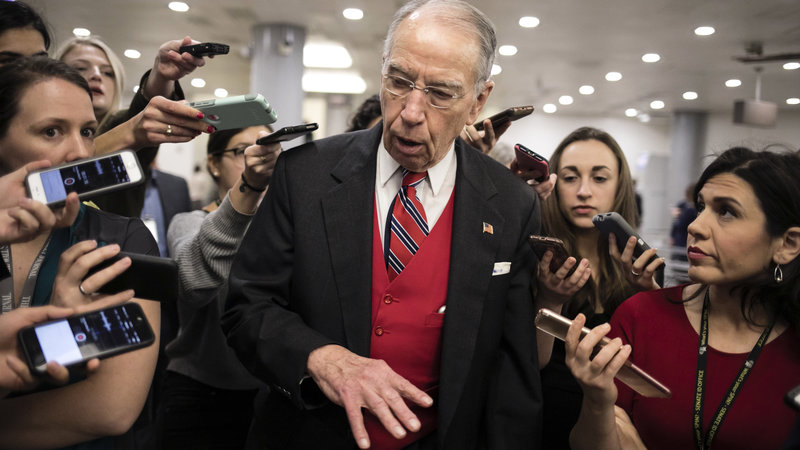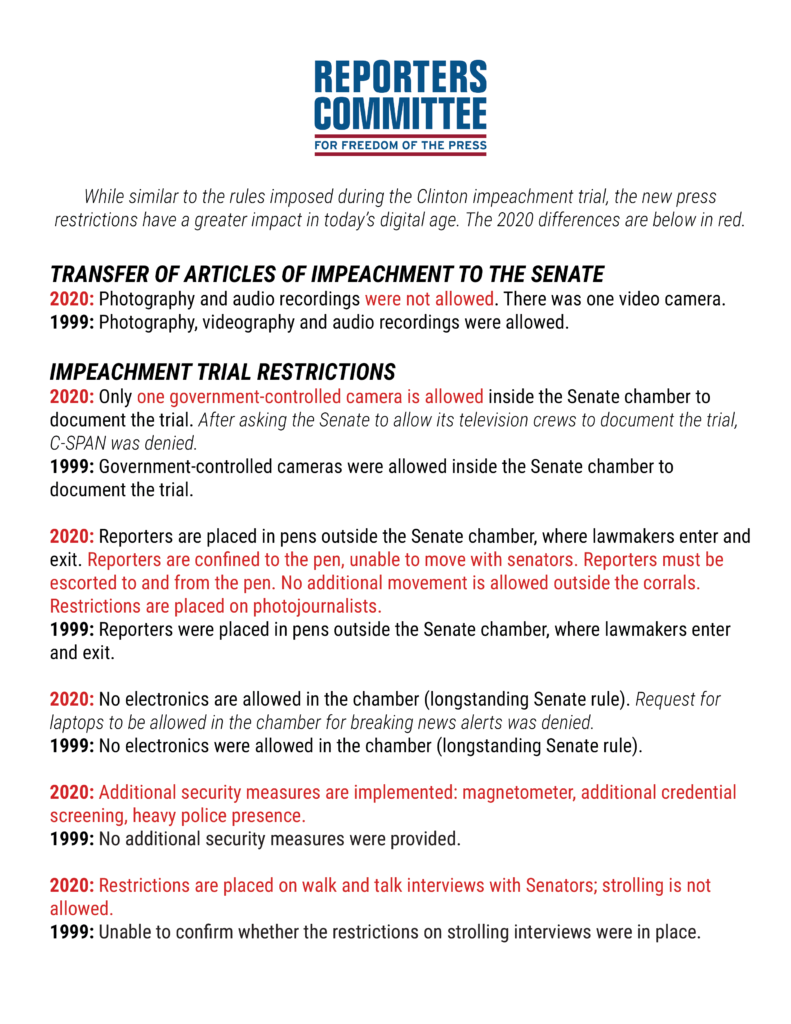Senate rules on impeachment press coverage restrict real-time reporting

Just two hours before President Trump’s impeachment trial began on Tuesday, the Senate Standing Committee of Correspondents received written descriptions of press coverage rules that already appear to be having a more significant impact than restrictions imposed on journalists covering President Clinton’s impeachment two decades ago.
The guidelines fail to address the concerns raised by the Reporters Committee’s letter sent to Senate leadership last week, highlighting the need for reporters to “respond quickly to rapid developments” and asking leadership to reconsider press restrictions that have been the subject of growing criticism over the past two weeks. Backlash was swift from press and civil society groups as they echoed the list of concerns raised by the Senate Standing Committee of Correspondents on Jan. 14.

Some of the restrictions are similar to those imposed during the 1999 Clinton impeachment trial — holding reporters in press pens outside the Senate chamber, a ban on electronic devices in the Senate chamber and permitting only Senate-controlled cameras in the chamber. However, there are additional screening devices in place to sniff out electronic devices, which appear not to have been present during the 1999 trial, and Senate leadership barred still photography during the transfer of the articles of impeachment from the House of Representatives to the Senate.
While some of the restrictions are similar to the Clinton trial, times have changed. In particular, the proliferation of electronic devices as an essential element of newsgathering means that the restrictions that may have been a headache in 1999 could more significantly impair as-it-happens reporting today.

Impeachment trials are historic events; there have only been three. The only one before Presidents Trump and Clinton was the 1868 impeachment trial of President Andrew Johnson. (Congress never tried President Nixon because he resigned the presidency before the House voted on articles of impeachment.)
The current trial is the first to feature novel information gathering and sharing tools like smartphones, laptops and social media. In contrast to the 1868 trial, which was reported with illustrations drawn by scores of “special artists,” and the 1999 trial, which occurred at the height of the cable news era, the current impeachment trial is taking place at a time when the public expects to access and consume news instantly online.
These technological advancements mean that restrictions that were an annoyance during the Clinton trial truly hinder modern news reporting today. In 1999, print reporters worked on a next-day deadline rather than for a 24-hour breaking news cycle. Reporters also barely used cell phones two decades ago, opting instead to communicate with their news desks using pagers.
Reporting from the first days of the current trial suggests that restrictions are indeed interfering with real-time reporting. CNN’s Manu Raju tweeted that reporters “are not allowed to talk with senators by floor as usual. We can only talk to them if they stop by our penned areas.”
“REPORTERS AREN’T SHEEP,” VICE News contributor Matt Laslo tweeted alongside a picture showing the photographers’ overcrowded press pen just off the Senate floor.
Journalists are also being escorted by Senate staff to walk about 15 yards between the two press holding areas in the Ohio Clock corridor, where they are put into a 5-by-10 foot pen in the spacious Senate Reception Room, which is otherwise mostly empty.
And reporters are required to walk through a magnetometer as they enter the Senate’s Daily Press Gallery to ensure they are not bringing electronic devices or digital recorders into the Senate chamber. On the eve of the Senate trial, AP reporter Andrew Taylor tweeted, “The press has had the right to walk, unfettered, through those doors and others to witness public sessions of the Senate since the 18th century. Tomorrow, there will be a police officer and a magnetometer in our way for the 1st time ever.”
In response to these restrictions, Sen. Martin Heinrich (D-NM) wrote a letter on Tuesday to Senate Sergeant-at-Arms Michael Stenger to voice his “extreme concern and discomfort” about the “draconian” restrictions, arguing that they are “antithetical to a free press, good governance, and the ability of the public to be fully informed about what we as elected leaders do in their name.”
The impeachment trial is a matter of intense public interest for Americans of all political stripes, and senators from both parties have rightly criticized these restrictions. Senate leadership should acknowledge the added burden the restrictions place on digital-age reporting, and immediately rescind these harmful restrictions.
The Reporters Committee regularly files friend-of-the-court briefs and its attorneys represent journalists and news organizations pro bono in court cases that involve First Amendment freedoms, the newsgathering rights of journalists and access to public information. Stay up-to-date on our work by signing up for our monthly newsletter and following us on Twitter or Instagram.
Photo by J. Scott Applewhite of the Associated Press